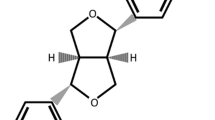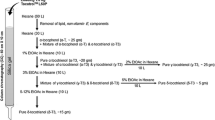Abstract
The tocotrienol-rich fraction (TRF) of palm oil consists of tocotrienols and some α-tocopherol (α-T). Tocotrienols are a form of vitamin E having an unsaturated side-chain, rather than the saturated side-chain of the more common tocopherols. Because palm oil has been shown not to promote chemically-induced mammary carcinogenesis, we tested effects of TRF and α-T on the proliferation, growth, and plating efficiency (PE) of MDA-MB-435 estrogen-receptor-negative human breast cancer cells. TRF inhibited the proliferation of these cells with a concentration required to inhibit cell proliferation by 50% of 180 μg/mL, whereas α-T had no effect at concentrations up to 1000 μg/mL as measured by incorporation of [3H]thymidine. The effects of TRF and α-T also were tested in longer-term growth experiments, using concentrations of 180 and 500 μg/mL. We found that TRF inhibited the growth of these cells by 50%, whereas α-T did not. Their effect on the ability of these cells to form colonies also was studied, and it was found that TRF inhibited PE, whereas α-T had no effect. These results suggest that the inhibition is due to the presence of tocotrienols in TRF rather than α-T.
Similar content being viewed by others
Abbreviations
- α-T:
-
α-tocopherol
- DMBA:
-
7,12-dimethylbenz(a)anthracene
- MTT:
-
3,(4,5-dimethylthiazol-2-yl)2,5-diphenyltetrazolium bromide
- PE:
-
plating efficiency
- TRF:
-
tocotrienol-rich fraction
References
Sylvester, P.W., Russell, M., Ip, M.M., and Ip, C. (1986) Comparative Effects of Different Animal and Vegetable Fats Before and During Carcinogenesis Administration on Mammary Tumorigenesis, Sexual Maturation and Endocrine Function in Rats,Cancer Res. 46, 757–762.
Sundram, K., Khor, H.T., Ong, A.S.H., and Pathmanathan, R. (1989), Effect of Dietary Palm Oils in Mammary Carcinogenesis in Female Rats Induced by 7,12-Dimethylbenz(α)anthracene,Cancer Res. 49, 1447–1451.
Kritchevsky, D., Weber, M.M., and Klurfeld, D.M. (1992) Influence of Different Fats (soybean oil, palm olein or hydrogenated oil) on Chemically-Induced Mammary Tumors in Rats,Nutr. Res. 12, S175-S179.
Hubbard, N.E., and Erickson, K.L. (1987) Influence of Dietary Fats on Cell Populations of Line Mouse Mammary Tumors; A Morphometric and Ultrastructural Study,Cancer Lett. 35, 281–294.
Hopkins, G.J., and Carroll, K.K. (1979) Relationship Between Amount and Type of Dietary Fat in Promotion of Mammary Carcinogenesis Produced by 7,12-Dimethylbenz(α)anthracene,J. Natl. Cancer Inst. 62, 1009–1012.
Clinton, S.K., Mulloy, A.L., and Visek, W.J. (1984) Effects of Dietary Saturation on Prolactin Secretion, Carcinogen Metabolism and Mammary Carcinogenesis in Rats,J. Nutr. 114, 1630–1639.
Gammal, E.B., Carroll, K.K., and Plunkett, E.R. (1967) Effects of Dietary Fat on Mammary Carcinogenesis by 7,12-Dimethylbenz-α-anthracene in Rats,Cancer Res 27, 1737–1742.
Rose, D.P., and Connolly, J.M. (1989) Stimulation of Growth of Human Breast Cancer Cell Lines in Culture by Linoleic Acid,Biochem. Biophys. Res. Comm. 164, 277–283.
Nesaretnam, K., Khor, H.T., Ganeson, J., Chong, Y.H., Sundram, K., and Gapor, A. (1992) The Effect of Vitamin E Tocotrienols from Palm Oil on Chemically Induced Mammary Carcinogenesis in Female Rats,Nutr. Res. 12, 879–892.
Tan, B. (1992) Antitumor Effects of Palm Carotenes and Tocotrienols in HRS/J Hairless Female Mice,Nutr. Res. 12, S163-S173.
Kato, A., Yamaoka, M., Tanaka, A., Komiyama, K., and Umezawa, I. (1985) Physiological Effect of Tocotrienols,Yakugaku Zasshi 34, 375–376.
Komiyama, K., and Yamaoka, M. (1989) Studies on the Biological Activity of Tocotrienols,Chem. Pharm. Bull. 37, 1369–1371.
Gould, M.N., Haag, J.D., Kennan, W.S., Tanner, M.A., and Elson, C.E. (1991) A Comparison of Tocopherol and Tocotrienol for the Chemoprevention of Chemically Induced Rat Mammary Tumors,Am. J. Clin. Nutr. 53, 1068s-1070s.
Yamaoka, M., and Carrillo, M.J.H. (1990) Effect of Tocopherols and Tocotrienols on the Physicochemical Property of the Liposomal Membrane in Relation to Their Antioxidant Activity,Chem. Phys. Lipids 55, 295–300.
Serbinova, E., Kagan, V., Han, D., and Packer, L. (1991) Free Radical Recycling and Intermembrane Mobility in the Antioxidant Properties of α-Tocopherol and α-Tocotrienol,Free Radic. Biol. Med. 10, 263–275.
Lathia, D., Braasch, A., and Theissen, U. (1988) Inhibitor Effects of Vitamin C and E onIn Vitro Formation ofN-Nitrosamine Under Physiological Conditions,Front. Gastrointest. Res. 14, 151–156.
Salomen, J.T., Salomen, R., and Lappetalainen, R. (1985) Risk of Cancer in Relation to Serum Concentrations of Selenium and Vitamin A and E, Match Case Control Analysis of Prospective Data,Br. Med. J. 290, 417–420.
Willet, W.C. (1986) Selenium, Vitamin E, Fiber and the Incidence of Human Cancer an Epidemiologic Perspective,Adv. Exp. Med. Biol. 206, 27–34.
Knekt, P., Aromaa, A., Maatela, J., Aaran, R.K., Nikkari, T., Hakama, M., Hakulinen, T., Peto, R., Saxen, E., and Teppo, L. (1988) Serum Vitamin E and Risk of Cancer Among Finnish Men During a Ten Year Follow-Up,Am. J. Epidemiol. 127, 28–41.
Knekt, P. (1988) Serum Vitamin E Level and Risk of Female Cancer,Int. J. Epidemiol. 17, 281–286.
Packer, L. (1991) Protective Role of Vitamin E in Biological System,Am. J. Clin. Nutr. 53, 1050S-1055S.
Sundram, K., and Gapor, A. (1992) A Vitamin E from Palm Oil Its Extraction and Nutritional Properties,Lipid Technolog., November/December, 137–141.
Price, J.E., Polyzos, A., Zhang, R.D., and Daniels, L.M. (1990) Tumorigenicity and Metastasis of Human Breast Carcinoma Cell Lines in Nude Mice,Cancer Res. 50, 717–721.
Hansen, M.B., Nielsen, S.E., and Burg, K. (1989) Re-Examination and Further Development of a Precise and Rapid Dye Method for Measuring Cell Growth/Cell Kill,J. Immunol. Methods 119, 203–210.
Leth, T., and Sondergaard, H. (1977) Biological Activity of Vitamin E Compounds and Natural Materials by the Resorption-Gestation Test and Chemical Determination of the Vitamin E Activity in Foods and Feeds,J Nutr. 107, 2236–2243.
Wattenberg, L.W. (1972) Inhibition of Carcinogenic and Toxic Effects of Polycyclic Hydrocarbons by Phenolic Antioxidants and Ethoxyquin,J. Natl. Cancer Inst. 48, 1425–1430.
Dayton, S., Hashimoto, S., and Wollman, J. (1977) Effect of High-Oleic and High Linoleic Safflower Oils on Mammary Tumors Induced in Rats by 7,12-Dimethylbenzanthracene,J. Nutr. 107, 1353–1360.
Welsch, C.W. (1992) Relationship Between Dietary Fat and Experimental Mammary Tumorigenesis: A Review and Critique,Cancer Res. 52, 2040s-2048s.
Sumiyoshi, H. (1985) Effects of Vitamin E Deficiency on 1,2 Dimethylhydrazine Induced Intestinal Carcinogenesis in Rats,Hiroshima J. Med. Sci. 34, 363–369.
Ip, C. (1982) Dietary Vitamin E Intake and Mammary Carcinogenesis in Rats,Carcinogenesis 3, 1453–1456.
Horvath, P.M. and Ip, C. (1983) Synergistic Effect of Vitamin E and Selenium in the Chemoprevention of Mammary Carcinogenesis in Rats,Cancer Res. 43, 5335–5341.
Ngah, W.Z.W., Jarien, Z., San, M.M., Marzuki, A., Top, G.M., Shamaan, N.A., and Kadir, K.A. (1991) Effects of Tocotrienols on Hepatocarcinogenesis Induced by 2 Acetylaminofluorene in Rats,Am. J. Clin. Nutr. 53, 1076s-1081s.
Author information
Authors and Affiliations
About this article
Cite this article
Nesaretnam, K., Guthrie, N., Chambers, A.F. et al. Effect of tocotrienols on the growth of a human breast cancer cell line in culture. Lipids 30, 1139–1143 (1995). https://doi.org/10.1007/BF02536615
Received:
Revised:
Accepted:
Issue Date:
DOI: https://doi.org/10.1007/BF02536615




